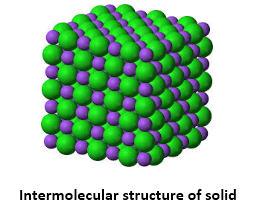WHAT IS MATTER
=Anything that occupie some space and having some mass are classified as matter..
TYPE OF MATTER
Matter are classified mainly as three states – solids, liquids, and gases. Most objects around us are in their solid state.
SOME IMPORTANT FACT ABOUT ARRANGEMENT OF ATOMS IN A MATTER
=Anything that occupie some space and having some mass are classified as matter..
TYPE OF MATTER
Matter are classified mainly as three states – solids, liquids, and gases. Most objects around us are in their solid state.
SOME IMPORTANT FACT ABOUT ARRANGEMENT OF ATOMS IN A MATTER
As we have studied before we can change the physical properties of an object or element by varying its temperature and pressure, This phenomenon is known as Change of State.
For example when we heat water to turn it into water vapor or freeze it to turn it into ice.
For example when we heat water to turn it into water vapor or freeze it to turn it into ice.
The states of matter and its stability actually depends on two opposing forces found in the atom of an element.
These are the two forces responsible for the formation and stability of a solid.
Let us discuss these two forces in some detail.
These are the two forces responsible for the formation and stability of a solid.
Let us discuss these two forces in some detail.
- Intermolecular Forces: Intermolecular forces exist between molecules of an element. They actually determine not only the state of the matter but also factors such as boiling point, melting point, enthalpy of the elements. They keep the atoms or molecules of matter close together in a bond.
- Thermal Energy: Thermal energy is a form of kinetic energy. It is the energy that particles possess due to their motion. It is the internal energy of an object that is responsible for its temperature. Transfer of thermal energy happens through the transfer of heat. With a rise in the thermal energy, the particles of matter tend to move faster and vice-versa.
These two forces keep the atoms of solids closely packed in a fixed structure we call a lattice. At low temperatures the thermal energy of particles of solid matter is low.
So the movement of particles is minimal, the intermolecular force is high and spaces between atoms is very less. This gives solid their basic properties.
So the movement of particles is minimal, the intermolecular force is high and spaces between atoms is very less. This gives solid their basic properties.
GENERAL PROPERTIES OF SOLID
If we actually observe all the solid objects around us, we will notice many dissimilarities between them.
Their shapes, texture, weight, size, colors etc may vary greatly.
But there are a few physical properties of a solid that holds true for all solids baring a few rare exceptions. some common/general characteristics of solids are...............
Their shapes, texture, weight, size, colors etc may vary greatly.
But there are a few physical properties of a solid that holds true for all solids baring a few rare exceptions. some common/general characteristics of solids are...............
General Characteristics of Solid State
Solid state is determined by following characteristics. They are:
- Definite mass, volume, and shape
- Short Intermolecular distance
- Strong Intermolecular Forces
- The constituent particles remain fixed at their positions and can only oscillate about their mean positions
- Solids are incompressible and rigid
- High Density
Definite Mass, Volume, and Shape
Solids have definite mass, volume, and shape because the constituent particles of matter are held together by strong intermolecular forces.
At low temperature the intermolecular force tends to dominate the thermal energy, the solids remain in the fixed state.
At low temperature the intermolecular force tends to dominate the thermal energy, the solids remain in the fixed state.
Example: Ice cube at low temperature remains in the solid state, but when we alter the physical conditions we find the ice to either melt or evaporate away.
Short Intermolecular Distance
The intermolecular distance between constituent particles of matter in a solid is short due to tight close packing.
The atoms and molecules are held close together by strong intermolecular forces.
The atoms and molecules are held close together by strong intermolecular forces.
Example: The intermolecular distance of solid is typical of the order 0.3 × 10-9 m.
Strong Intermolecular Forces
In solids the intermolecular forces are quite strong; this is because of the closeness of constituent particles of matter.
The variation in intermolecular forces depicts why solids behave differently than liquids and gases.
The variation in intermolecular forces depicts why solids behave differently than liquids and gases.
The constituent particles remain fixed at their positions and can oscillate only about their mean positions
[1]=As formation and existence of solids are possible only at low temperatures,
[2]=The intermolecular forces are high enough to keep the atoms and molecules in a solid fixed at their positions.
Also, the thermal energy is quite less and can only make atoms and molecules oscillate at their positions.
[2]=The intermolecular forces are high enough to keep the atoms and molecules in a solid fixed at their positions.
Also, the thermal energy is quite less and can only make atoms and molecules oscillate at their positions.
Solids are incompressible and rigid
: The particles are tightly packed inside solid
Solids are rigid and incompressible in nature due to strong intermolecular forces acting on particles which keep them fixed on their positions.
Example: Wood, Metals etc. are all kinds of incompressible solids.
High Density
The mass of solid is greater than that of liquids and gases.
Also, since solids have fixed volume, solids show high density
Also, since solids have fixed volume, solids show high density


No comments:
Post a Comment